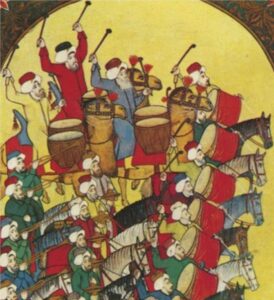Wolfgang Amadeus Mozart (1756-1791) Marsch der Janitscharen aus „Die Entführung aus dem Serail“, KV 384 / March of the Janissaries from „The Abducation from the Seraglio“

Die Janitscharenmusik war ursprünglich die Militärmusik der Osmanen. Im Zuge der Türkenkriege wurde die Musik der Janitscharen in Österreich bekannt und fand als Türkische Musik in der klassischen Musik Verwendung. Mozart hat im ersten Akt des Singspiels „Die Entführung aus dem Serail“ diesen Marsch an jener Stelle eingefügt, da Bassa Selim mit Konstanze zum ersten Mal auf der Bühne erscheinen. Die Janitscharen, seine Leibgarde, kündigen somit den Auftritt des Herrschers und Konstanze an. Bei der Wahl der Blasinstrument entscheidet sich Mozart, neben zwei Flöten, für die bei den europäischen Militärkapellen „alla turka“ üblichen Instrumenten, wie Klarinetten, Fagotte, Hörner, Trompete einzusetzen, verzichtet aber auf die bei den Janitscharen gebräuchlichen Oboen (Zurna). Von den charakteristischen Schlaginstrumenten verwendet Mozart eine türkische Trommel und eine deutsche Trommel.

Janissary music was originally the military music of the Ottomans. In the course of the Turkish wars, the music of the Janissaries became known in Austria and was used as Turkish music in classical music. In the first act of the opera”„The Abducation from the Seraglio”, Mozart insted this march at the point where Bassa Selim appeared on stage with Konstanze for the first time. The janissaries, his bodyguard, thus announce the appearance of the ruler and Konstanze. When choosing wind instruments, Mozart opted for two flutes and the instruments customary in the European military bands “alla turka”, such as clarinets, bassoons, horns, trumpet, but dispensed with the oboes (zurna) commonly used by the Janissaries. Of the characteristic percussion instruments, Mozart uses a Turkish drum and a German drum.
| sound sample / Tonbeispiel | score/parts PDF download: € 32,- | add to cart / in den Warenkorb |
